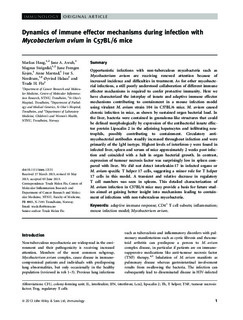Dynamics of immune effector mechanisms during infection with Mycobacterium aviumin C57BL/6 mice
Haug, Markus; Awuh, Jane Atesoh; Steigedal, Magnus; Kojen, June Frengen; Marstad, Anne; Nordrum, Ivar Skjåk; Halaas, Øyvind; Flo, Trude Helen
Journal article, Peer reviewed
Accepted version
Permanent lenke
http://hdl.handle.net/11250/2456434Utgivelsesdato
2013Metadata
Vis full innførselSamlinger
Sammendrag
Opportunistic infections with non-tuberculous mycobacteria such as Mycobacterium avium are receiving renewed attention because of increased incidence and difficulties in treatment. As for other mycobacterial infections, a still poorly understood collaboration of different immune effector mechanisms is required to confer protective immunity. Here we have characterized the interplay of innate and adaptive immune effector mechanisms contributing to containment in a mouse infection model using virulent M. avium strain 104 in C57BL/6 mice. M. avium caused chronic infection in mice, as shown by sustained organ bacterial load. In the liver, bacteria were contained in granuloma-like structures that could be defined morphologically by expression of the antibacterial innate effector protein Lipocalin 2 in the adjoining hepatocytes and infiltrating neutrophils, possibly contributing to containment. Circulatory antimycobacterial antibodies steadily increased throughout infection and were primarily of the IgM isotype. Highest levels of interferon-c were found in infected liver, spleen and serum of mice approximately 2 weeks post infection and coincided with a halt in organ bacterial growth. In contrast, expression of tumour necrosis factor was surprisingly low in spleen compared with liver. We did not detect interleukin-17 in infected organs or M. avium-specific T helper 17 cells, suggesting a minor role for T helper 17 cells in this model. A transient and relative decrease in regulatory T cell numbers was seen in spleens. This detailed characterization of M. avium infection in C57BL/6 mice may provide a basis for future studies aimed at gaining better insight into mechanisms leading to containment of infections with non-tuberculous mycobacteria.
